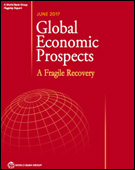Connecting to Compete 2023: Trade Logistics in the Global EconomyConnecting to Compete presents the findings from the latest data from the 2023 Logistics Performance Index (LPI) and its six component indicators: Customs, infrastructure, international shipments, logistics competence, tracking and tracing, and timeliness. The seventh edition, which now covers 139 countries, is released following unprecedented disruptions in supply chains amid the global coronavirus (COVID-19) pandemic. Author: World Bank Year: 2023 Download Tags: WB, Trade, Logistics, South Asia  Expanding Opportunities: Toward Inclusive GrowthGDP in South Asia is estimated to grow at 5.6% in fiscal year FY2023 and 5.9% in FY2024, backed by the recovery in services and lower commodity prices. GDP growth in Bangladesh will decelerate to 5.2% in FY2022-2023 due to global economic uncertainty, before recovering to 6.2% in FY2024. In Bhutan, GDP is projected to expand at 4.5% in FY2022-2023 as the further reopening of borders support growth in industry and services. GDP growth in India will moderate to 6.3% in FY2023-2024 following slower growth in consumption. Maldives is seeing a return to the tourism sector's pre-pandemic levels with GDP growth projections in FY2023 at 6.6%. Growth in Nepal will slow to 4.1% in FY2023 following import restrictions, before rising to 4.9% in FY2024. In Sri Lanka, amid fiscal and external imbalances, GDP growth is estimated at -4.3% in FY2023 and 1.2% FY2024. In Southeast Asia, the Myanmar Economic Monitor projects Myanmar's economic recovery accelerating to 3% in the year to September 2023 following growth in industry and services. Author: World Bank Year: 2023 Download Tags: WB, Bangladesh, Bhutan, Sri Lanka, Services, India, Maldives, Myanmar, Nepal  South Asia Economic Focus (Fall 2022) Coping with Shocks: Migration and the Road to ResilienceReal gross domestic product (GDP) in South Asia is projected to slow to 5.8% in fiscal year (FY) 2022 and FY2023. In Bangladesh, real GDP growth is projected at 6.1% in FY2022-2023, as higher inflation and rolling power outages dampen post-coronavirus economic recovery in consumption and investment. The easing of mobility restrictions is supporting Bhutan's recovery amid one of the highest vaccination rates globally. With slower domestic demand, real GDP forecast in Bhutan is set at 4.1% in FY2022-2023. In India, where exports and overall economic activity have recovered more strongly than the rest of the world, growth is forecast at 6.5% in FY2022-2023. In Maldives, real GDP is expected to grow by 12.4% in FY2022 and 8.2% in FY2023 on the recovery of tourism. Growth forecast in Nepal is set at 5.1% in FY2022-2023 amid normalization of monetary policy. Real GDP in Sri Lanka is projected at -9.2% in FY2022 and -4.2% in FY2023 due to a severe balance of payment crisis and risks posed by the country's political situation. Author: World Bank Year: 2022 Download Tags: WB, South Asia  Reshaping Norms: A New Way ForwardSouth Asian countries are emerging from coronavirus (COVID-19) pandemic burdened by high inflation and fiscal imbalances, as well as external shocks. In Bangladesh, gross domestic product (GDP) is projected to increase by 6.4% in fiscal year (FY) 2021-2022 and 6.7% in FY2022-2023. In Bhutan, FY2021-2022 growth is estimated at 4.4% and FY2022-2023 growth at 4.7%, with the expected return of international tourists and migrant workers from India. In India, FY2022-2023 growth is projected at 8%, slightly below last year’s rate. Economic recovery in Maldives will stay strong in 2022, with real GDP growth expected to grow by 8.5% in 2022 and 9.1% in 2023. In Nepal, tourism has yet to recover, with growth projected at 3.7% in FY2021-2022 and 4.1% in FY2022-2023. Hydropower in Nepal is providing a natural hedge against increases in crude oil-based energy prices. Growth in Sri Lanka is hampered by a series of shocks amid high debt, with 2022 growth projected at 2.4%. Author: World Bank Year: 2022 Download Tags: WB, South Asia, Bangladesh, Bhutan, India, Maldives, Nepal, Sri Lanka South Asia Economic Focus, Fall 2021South Asia continued to recover from the coronavirus (COVID-19) pandemic with growth set to rise by 7.1% in 2021 and 2022. Growth in Bangladesh is estimated at 6.4% in fiscal year (FY) 2021-2022 with the recovery of exports and private consumption. Bhutan GDP is projected to grow by 3.6% supported by migrant labor and public infrastructure projects. India is projected to grow by 8.3% in FY2021-2022 on the back of incentives to increase domestic demand and manufacturing. With the return of tourism in Maldives, the country’s output is expected to grow at 23.3% in 2021. Nepal GDP is estimated to grow by 3.9% as vaccination picks up and tourism and migrant worker flow recover. With pressure from the spread of the COVID-19 Delta variant in June 2021, real GDP in Sri Lanka is projected to grow by 3.3% in 2021. Author: World Bank Year: 2021 Download Tags: South Asia, WB, COVID-19 Achieving Energy Security in Asia: Diversification, Integration and Policy ImplicationsThis publication reviews the status of energy security in Asia. In South Asia, countries face challenges in achieving energy security and climate goals. India and Bangladesh, for instance, face rising energy import bills while Maldives depends on oil products. The book suggests that countries and regions can achieve energy security through energy cooperation and diversification. This would lead to economic growth and poverty reduction, as well as mitigate energy security risks from climate change. Author: Asian Development Bank Institute and World Scientific Year: 2019 Download Tags: WB, India, Bangladesh, Maldives, Energy, Climate Change Doing Business 2020From May 2018 to May 2019, 294 regulatory reforms were implemented worldwide to make it easier to do business. India was among the countries that showed the most notable improvement in doing business during the period. South Asia had the highest share of economies that implemented cross-border cooperation reform, which ensures easy customs clearance procedures, harmonization of compliance rules, and border control efficiency. For example, Nepal opened a new integrated check post with India, thereby decreasing the time to import and export. Author: World Bank Group Year: 2019 Download Tags: WB, Ease of Doing Business, Customs, South Asia, Harmonisation World Bank East Asia and Pacific Economic Update, October 2019: Weathering Growing RisksAmid weakening global demand and policy uncertainty regarding trade tensions, growth in developing East Asia and Pacific region slowed in the first half of 2019. There is a need to address vulnerabilities and preserve economic dynamism in developing economies in the region. In Myanmar, GDP growth will reach 6.8% in 2021/2022 with the projected pick-up in agriculture. Policy measures to encourage investment, such as those for the energy sector, are expected to strengthen Myanmar’s manufacturing and construction sectors. Author: World Bank Year: 2019 Download Tags: Energy, Investment, Myanmar, WB Services for Trade Competitiveness: Country and Regional Assessments of Services TradeThis book applies methodologies for assessing competitiveness of countries’ services sector. It examines the types of barriers to services in the regulatory environment and identifies the policy implications. It aims to guide policymakers in the area of services in international trade. The chapter on diversifying Nepal’s economy assesses the country’s trade potential in services. Using the Services Trade Competitiveness Diagnostic toolkit, it identifies policy measures that can help Nepal identify strategies for greater integration in the global marketplace. Author: Claire Hollweg and Sebastian Saez, eds. Year: 2019 Download Tags: Energy, Nepal, Services, Trade, WB Global Economic Prospects, June 2019South Asia enjoyed solid economic activity in 2018 with gross domestic product (GDP) growth at 7% owing to strong domestic demand. Risks to the outlook include possible re-escalation of political uncertainties, financial sector weaknesses due to nonperforming assets, and fiscal challenges amid elections in several countries. Author: World Bank Group Year: 2019 Download Tags: WB, South Asia, Trade Doing Business 2019: Training for ReformA record 314 reforms were undertaken around the world, serving to improve business climate in the past year. South Asian economies carried out 19 reforms, many of which focused on improving starting a business, access to credit, paying taxes, and resolving insolvency. South Asia scored the highest for trading across borders. India continued its reform agenda and advanced 23 slots to 77th place in the global ranking, making it South Asia’s top-ranked economy. Bhutan introduced an online platform for filling corporate and personal income tax. Sri Lanka climbed to 100th place after instituting reforms on paying taxes and enforcing contracts. Author: World Bank Group Year: 2018 Download Tags: Ease of Doing Business, South Asia, Trade Facilitation, WB The WEB of Transport Corridors in South AsiaThis book looks at how the economic benefits of investments in transport corridors could be amplified and how negative impacts could be minimized in South Asia. The book introduces an appraisal methodology that looks at the web of interconnected elements around corridors and assesses proposed corridors according to their potential to bring wider economic benefits (WEB). It uses case studies of past and recent corridor initiatives, and presents a simulation of the impact of the proposed Kolkata-Dhaka corridor. Author: Asian Development Bank, JICA, UKAID, World Bank Year: 2018 Download Tags: ADB, Economic Corridor Development, Gender, Regional Integration, Roads, Trade, Transport, WB, ADB RCI East Asia Pacific Economic Update, April 2018: Enhancing PotentialEast Asia and Pacific (EAP) grew slightly faster than anticipated in 2017, with growth in Myanmar rebounding slightly at 6.4% due to strong exports. Amid risks to macroeconomic stability, EAP countries must enhance trade facilitation and integration, improve education systems, and upgrade capabilities of workers and managers. Author: World Bank Year: 2018 Download Tags: Exports, GDP, India, Manufacturing, Myanmar, Poverty Reduction, Trade Facilitation, WB Transport Corridors and their Wider Economic Benefits: A Critical Review of the LiteratureThis paper reviews literature estimating the impact of large transport investments. It reviews 78 studies, 11 of which centers on infrastructure projects in India. The paper looks at the economic benefits of transport infrastructure projects to better understand how corridors could generate wider economic benefits, with a focus on roads, rails, and waterways. The review assesses the impact of transport corridor projects on economic welfare and equity, environmental quality, and social inclusion, and suggests a need for policies and institutions that address trade-offs. Author: Mark Roberts, Martin Melecky, Theophile Bougna, and Yan Sarah Xu Year: 2018 Download Tags: Economic Corridor Development, India, Infrastructure, Investment, Railway, Roads, Transport, WB Global Investment Competitiveness Report 2017/2018: Foreign Investor Perspectives and Policy ImplicationsThis report provides analytical insights and empirical evidence on foreign direct investment’s (FDI) drivers and contributions to economic transformation. Data are categorized by sector and geographic origin and destination of investment, including analysis for SASEC countries using data for Bangladesh, Bhutan, India, Myanmar, Nepal, and Sri Lanka. The report explores the potential of FDI to create growth for local firms, assesses the effectiveness of fiscal incentives in attracting FDI, and gives practical recommendations to developing countries. Author: World Bank Group Year: 2018 Download Tags: Bangladesh, Bhutan, FDI, India, Nepal, Sri Lanka, Trade, WB, Myanmar Doing Business 2018: Reforming to Create JobsDoing Business, an annual publication of the World Bank, presents quantitative indicators on business regulations that can be compared across 190 economies and over time. The report finds that entrepreneurs in 119 economies saw improvements in their local regulatory framework, including reforms for reducing complexity in regulatory processes for starting businesses. South Asia scores well for starting a business, though it scores only an average of 33.04 for resolving insolvency. India has the highest score in South Asia for protecting minority investors. Patterns show further room for improvement across all regions and at all income levels. Author: World Bank Group Year: 2017 Download Tags: Ease of Doing Business, South Asia, WB Measuring and Analyzing the Impact of GVCs on Economic Development (English)This report shows how the global economy is changing continuously and rapidly. It attempts to give a detailed picture of the dynamic network structure of the global economy, and tries to show how economies link up, specialize, and grow, in light of global value chains. It explains the difference between elements of an economy that are tradable and those that are non-tradable, while also presenting a picture of evolving patterns of independence. Author: Asian Development Bank Year: 2017 Download Tags: Development, WB, WTO The Little Green Data Book 2017Based on World Development Indicators 2017 and its online database, the Little Green Data Book 2017 looks at development and the environment through more than 50 indicators for all countries around the world. This edition features indicators on capture fisheries, aquaculture production, and marine-related areas, focusing on the economic importance of fisheries for sustainable development. Author: World Bank Year: 2017 Download Tags: Environment, WB, Development, Sustainability World Development Indicators 2017This report compiles statistics on global development, with this years’ database including more indicators covering the Sustainable Development Goals and more data disaggregated by sex, age, wealth quintile, and urban or rural location. The online database (http://data.worldbank.org) now includes more than 1,400 indicators for more than 220 economies (including those from South Asia), with some data series extending back more than 50 years. Author: World Bank Year: 2017 Download Tags: WB, Development, Sustainable Development Goals, South Asia  June 2017 Global Economic Prospects: A Fragile RecoveryThe World Bank forecasts that global growth will strengthen to 2.7% in 2017 amid a pickup in manufacturing and trade, rising confidence, favorable global financing conditions, and stabilizing commodity prices. In South Asia, growth is projected to remain strong at 6.8% in 2017. India is recovering from the temporary adverse effects of the end-2016 withdrawal of large-denomination currency notes. Activity in Bangladesh is moderating, reflecting a pullback in domestic demand and industrial production. Regional growth is expected to steady in 2018-2019, reaching an average of 7.2%, supported by strong domestic demand, a small rise in exports, and strong foreign direct investment. The regional outlook has been slightly revised down from January, reflecting a more protracted recovery in private investment in India than previously expected. Author: World Bank Group Year: 2017 Download Tags: WB, Bangladesh, FDI, India, Manufacturing, South Asia, Trade Climbing Higher: toward a Middle-income NepalNepal is experiencing modest growth but brisk poverty reduction. It has halved the poverty rate in just seven years and witnessed an equally significant decline in income inequality. Yet Nepal remains one of the poorest and slowest-growing economies in Asia, with per capita income falling behind its regional neighbors. The report discusses the need for comprehensive policy reform to address the country’s challenges in becoming a lower-middle-income country by 2030. The report outlines suggested reforms to facilitate greater investment and improved productivity, build new sources of growth, and deepen human capital. Author: World Bank Group Year: 2017 Download Tags: Employment, Investment, Nepal, Poverty Reduction, Trade, Transport, WB The Little Data Book on Information and Communication TechnologyThis book presents quick indicators for more than 200 countries showing data on key indicators of information and communications technology (ICT), including access, quality, affordability, efficiency, sustainability, and applications. It includes data for Bangladesh, Bhutan, India, Maldives, Myanmar, Nepal, and Sri Lanka. Author: World Bank and International Telecommunications Union Year: 2017 Download Tags: Bangladesh, Bhutan, ICT, India, Maldives, Myanmar, Nepal, Sri Lanka, South Asia, WB South Asia’s Turn: Policies to Boost Competitiveness and Create the Next Export PowerhouseWill South Asia become the next global factory? By 2030 more than a quarter of the world’s working adults will live in South Asia. As the work force ages and labor costs rise in China and other East Asian countries, many eyes turn to South Asia. According to this report, to realize the region’s potential, countries in South Asia should increase regional and global integration, take advantage of agglomeration economies, strengthen firm capabilities, and improve the business environment. Author: Gladys Lopez‐Acevedo, Denis Medvedev, and Vincent Palmade Year: 2017 Download Tags: Bangladesh, India, Regional Integration, South Asia, Trade, WB Doing Business 2017: Equal Opportunity for AllGovernments including that of India have relied on Doing Business to provide insights into good practices worldwide. Doing Business 2017: Equal Opportunity for All presents quantitative indicators on business regulations that can be compared across 190 economies. It shows how South Asia can work to improve certain areas, including removing restrictions on women’s right to work. It also shows how South Asia has been the most successful region in terms of trading across borders. Bhutan, with a global ranking of 73, ranks highest among South Asian countries. Author: World Bank Group Year: 2017 Download Tags: Trade Facilitation, Ease of Doing Business, Transport, WB Competitiveness of South Asia’s Container Ports: A Comprehensive Assessment of Performance, Drivers, and CostsAs a result of inefficiencies in South Asia’s container ports, the average cost of exporting or importing a container in the region is more than double that in East Asia. Better port logistics could help increase trade, diversify exports, attract more foreign direct investment, and spur economic growth. As container traffic continues to grow in South Asia, the best way to improve port performance is by increasing productivity. This report examines the performance of the 14 largest container ports in the region, identifying key drivers of port performance and examining differences in performance across ports. Author: Matías Herrera Dappe and Ancor Suárez-Alemán Year: 2016 Download Tags: Customs, Economic Growth, FDI, Infrastructure, Investment, South Asia, Trade, WB South Asia Economic Focus, Fall 2016: Investment Reality CheckSouth Asia continues on a path of gradual acceleration in 2016, led by a solid India. However, amid the resilience to external headwinds, including China’s slowdown and uncertainty surrounding monetary policy in advanced economies, South Asia is starting to feel the effect of slowing remittance flows or waning oil price dividends. Against this backdrop, this World Bank publication forecasts growth for the region at 7.1% in 2016, with its medium-term performance strongly dependent on investment and export turnout. India is set to grow at 7.6% in 2016, with the same speed as in 2015, but may increase its pace again in 2017 to 7.7%. The report highlights how private investment is a key future growth driver across South Asia that could help further boost the pace of economic activity. Author: World Bank Year: 2016 Download Tags: India, South Asia, Investment, Economic Growth, WB, Export The Little Green Data Book 2016The Sustainable Development Goals (SDGs) put environmental concerns on par with economic and social ones. The environment cuts across all the SDGs and is directly reflected in at least seven goals. The 2016 Little Green Data Book provides 50 indicators for 200 countries. Several indicators have the potential to measure progress on the SDGs as well as highlight important trends in the environment more broadly. The indicators are part of the larger World Development Indicators compiled annually by the World Bank from many different data sources. Author: World Bank Group Year: 2016 Download Tags: Energy, Environment, South Asia, WB Doing Business 2016The World Bank's Doing Business 2016: Measuring Regulatory Quality and Efficiency reports that South Asia ranked second among regions, after Europe and Central Asia, in the largest share of economies implementing at least one reform to make doing business easier in the past year. 6 out of 8 economies in South Asia implemented a total of 9 reforms, including Bhutan, India - following the Government of India's ambitious program to increase ease of doing business launched in 2014 - and Sri Lanka. However, South Asia still lags behind in use of online systems in regulatory processes. The highest ranked economy in the region is Bhutan, with a global ranking of 71. Author: The World Bank Year: 2015 Download Tags: Business Efficiency, ICT, Bhutan, WB Cross-Border Electricity Cooperation in South AsiaStrengthening cross-border electricity cooperation in South Asia can be part of the solution for providing adequate and reliable electricity. This World Bank Policy Research Working Paper reviews the status of cross-border electricity cooperation in South Asia, identifies key regional-level barriers to expand cross-border cooperation and trade in South Asia, and discusses the extent to which current domestic sector policies impede greater cross-border electricity cooperation. Finally, the findings offer policy recommendations on increased cross-border trade and cooperation. Author: Anoop Singh, Tooraj Jamasb, Rabindra Nepal, and Michael Toman Year: 2015 Download Tags: Energy, Regional Cooperation, Regional Trade, Bangladesh, Bhutan, India, Maldives, Nepal, South Asia, Sri Lanka, Trade, Trade Policy, WB Doing Business 2015: Going Beyond EfficiencyThe World Bank Group’s Doing Business Report 2015 is the 12th in its annual series of investigations into regulations that enhance business activity. Its indicators analyze economic outcomes and identify reforms to promote better regulatory frameworks for development, job creation, and growth. For the first time this year, the Doing Business report extends its coverage beyond the second largest city to include economies with a population of more than 100 million such as Chittagong in Bangladesh, and Delhi in India. The data provides insights into the variability of business regulations within economies. Author: The World Bank Year: 2014 Download Tags: Asia-Pacific, Bangladesh, India, Ease of Doing Business, Bangladesh, WB South Asia Economic Focus: The Export OpportunityThis bi-annual report presents the recent economic developments, outlook, and policy of the following South Asian countries – Afghanistan, Bangladesh, Bhutan, India, the Maldives, Nepal, Pakistan, and Sri Lanka. It highlights developing country growth as fairly robust. Meanwhile, India’s growth rate is slowly increasing and its inflation rate declining. South Asian economies solidified their external positions by easing pressures to finance current account deficits, yet face domestic challenges such as reducing fiscal risks, supporting higher levels of investment, and sustaining export growth. Author: The World Bank Year: 2014 Download Tags: South Asia, Trade, Economics, WB, Bangladesh, Bhutan, India, Maldives, Nepal, Sri Lanka Unlocking Bangladesh-India Trade: Emerging Potential and the Way ForwardThis working paper breaks down the importance of trade cooperation between Bangladesh and India by taking a closer look at the impacts of Bangladesh's increased market access to India, and their improved border connectivity. Employing data from national government resources and multilateral development organizations including the International Monetary Fund, World Bank, and World Trade Organization, the study provides an estimate of the trade potential of Bangladesh and India, and calculates the implications on costs of trade facilitation, among others. It also discusses ongoing challenges in bilateral relations and provides recommendations that will enable larger gains for the two contiguous countries. Author: Prabir De, Selim Raihan, and Sanjay Kathuria Year: 2012 Download Tags: Trade, Trade Facilitation, Regional Cooperation, Bangladesh, India, WB, WTO, Bilateral Trade |



